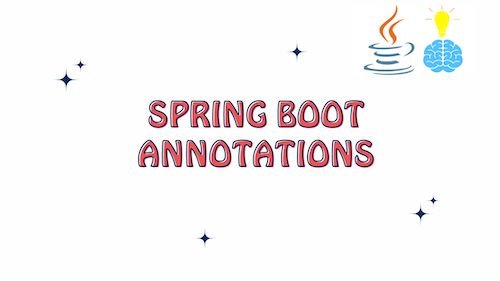In this article, we will explore top 16 Spring Boot Annotations which every developer should know. So, let’s get started.

Core Spring Boot Annotations
@SpringBootApplication: This annotation marks a class as a Spring Boot application. It combines@Configuration,@EnableAutoConfiguration, and@ComponentScan.
Read More : @SpringBootApplication Annotation
@EnableAutoConfiguration: Enables automatic configuration of Spring Boot based on project dependencies.
Read More : Spring Boot : Auto Configuration
Auto-Configuration Conditions Annotations
These annotations are used to conditionally enable or disable auto-configuration based on specific conditions.
@ConditionalOnClass: Specifies that a bean should be created only if a specified class is present on the classpath.@ConditionalOnMissingClass: Specifies that a bean should be created only if a specified class is missing from the classpath.@ConditionalOnBean: Specifies that a bean should only be created if another bean of a specific type is already present in the application context.@ConditionalOnMissingBean: Specifies that a bean should only be created if another bean of a specific type is not already present in the application context.@ConditionalOnProperty: Allows you to enable or disable components or configurations based on the values of properties in the configuration files.@ConditionalOnResource: Specifies that a bean should only be created if a certain resource is present.@ConditionalOnWebApplication: Specifies that a bean should only be created if the application is a web application.@ConditionalOnNotWebApplication: Similar to@ConditionalOnWebApplication, but creates components when the application is not a web application.@ConditionalOnExpression: Allows you to conditionally create a bean based on a SpEL (Spring Expression Language) expression.@ConditionalOnJava: Specifies that a bean should be created based on the Java version.
Read More : Top 10 Spring Boot Conditional Annotations
Spring Boot Annotations : Configuration Properties
These annotations are used for configuring properties.
@ConfigurationProperties: Used to bind external configuration properties to a Spring Boot bean.
Read More : @ConfigurationProperties
@EnableConfigurationProperties: Enables the automatic resolution of@ConfigurationPropertiesbeans.
Testing Annotations
These annotations are commonly used for testing Spring Boot applications.
@SpringBootTest: Used for integration testing, it specifies how to load the Spring ApplicationContext.@MockBean: In testing, it allows you to mock a bean when using@SpringBootTest.@DataJpaTest: Used for JPA repository tests, it configures an in-memory database and scans for relevant JPA components.@WebMvcTest: For testing the Spring MVC layer, it configures a limited Spring ApplicationContext.
Here’s a simple Java code example that demonstrates the use of these Spring Boot testing annotations:
import org.junit.jupiter.api.Test;
import org.springframework.beans.factory.annotation.Autowired;
import org.springframework.boot.test.autoconfigure.orm.jpa.DataJpaTest;
import org.springframework.boot.test.autoconfigure.web.servlet.WebMvcTest;
import org.springframework.boot.test.mock.mockito.MockBean;
import org.springframework.boot.test.context.SpringBootTest;
// Import other necessary dependencies and classes as needed
@SpringBootTest
public class MyIntegrationTest {
@Autowired
private MyService myService; // Inject a real bean
@MockBean
private MyMockedService mockedService; // Mock a bean
@Test
public void testIntegrationWithRealAndMockedBeans() {
// Your integration test logic here
// You can use both real and mocked beans in this test
}
}
@DataJpaTest
public class MyJpaRepositoryTest {
@Autowired
private MyJpaRepository jpaRepository; // Auto-configured JPA repository
@Test
public void testJpaRepository() {
// Your JPA repository test logic here
// Spring Boot configures an in-memory database for this test
}
}
@WebMvcTest(MyController.class)
public class MyWebMvcTest {
@Autowired
private MockMvc mockMvc; // Mocked Spring MVC environment
@Test
public void testController() throws Exception {
// Your Spring MVC controller test logic here
// Spring Boot configures a limited Spring ApplicationContext for this test
}
}
Conclusion: Spring Boot Annotations
This article has provided a comprehensive overview of the top 16 Spring Boot annotations that every developer should be familiar with. These annotations play a pivotal role in configuring, customizing, and optimizing Spring Boot applications.
We explored core Spring Boot annotations like @SpringBootApplication and @EnableAutoConfiguration, which are fundamental in setting up a Spring Boot application. Additionally, we delved into conditional annotations such as @ConditionalOnClass, @ConditionalOnBean, and @ConditionalOnProperty, which allow developers to fine-tune the auto-configuration of their applications based on specific conditions.
The article also covered annotations related to configuration properties, such as @ConfigurationProperties and @EnableConfigurationProperties, which are crucial for binding external configuration properties to Spring Boot beans.
Lastly, we discussed testing annotations like @SpringBootTest, @MockBean, @DataJpaTest, and @WebMvcTest, which simplify the process of testing Spring Boot applications.
Understanding and effectively utilizing these Spring Boot annotations empowers developers to build robust, configurable, and well-tested applications in a streamlined manner.
Must-Read Spring Boot Related Articles:
